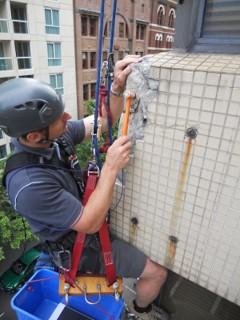Case 1
- Introduction
- Causes of Defects
- Good Practices
- Standards
- Maintenance and Diagnostics
- Remedial
- Similar Cases
- References
Maintenance and Diagnostics
Maintenance
Consider availability of adequate water supply, drainage provisions and electrical power supply to choose a façade cleaning method. Records of cleaning operations (including photographs before and after cleaning, and drawings of nature of deposits, thickness and patterns) should be kept for buildings of significance in accordance with BS 8221-1, SS 509-1 or equivalent. Maintain the façade in a state as near as possible to its new condition. Ease of façade maintenance can be expressed by the frequency of necessary maintenance operations, labour and supplies necessary for each maintenance operation,
and number of possible ways of removing stains, graffiti, etc., or ISO 7361 or equivalent.
Detect/determine staining of porous substrates by joint sealants (ISO/NP 16938-1). Adopt the recommendations for treatments for controlling organic growth in accordance with BS 8221-2,
SS509-2 or equivalent. Repair painted surfaces damaged by wear and tear; wash down; remove defective
paint film; apply sealer/primer (if necessary); and repaint in accordance with BS 6150, SS 542 or equivalent. TiO2 only works where there is sunlight. Conventional cleanings are still needed for non-coated areas. For areas coated with TiO2, conduct neutral cleaning annually.
Periodic cleaning is necessary to maintain the aesthetics of tiled façades. A neutral cleaning agent should be adequate if a periodic maintenance schedule is performed.
| Condition of Ceramic Tiled Wall | Cleaning Method |
| Unglazed ceramic tiles Glazed ceramic tiles | Scrubbing with washing soda or tri-sodium phosphate. Rinse well. Use plain water to remove soil. Occasionally for heavier soil use a mild detergent solution, rinse well. |
| Mosaic tiles | Washing with an abrasive cleaner such as brushing can be effective. Pressure blasting can also be considered to wash away dirt trapped at the joints. |
| Efflorescence | Removed by dry brushing or with water and a stiff brush. Heavy efflorescence may be removed with a solution of muriatic acid and scrubbing. Wet the surface well before and after the solution is applied. |
| Mildew | Remove with a dilute solution of chlorine bleach in water |
| Biological growth | Use a weak acid such as vinegar. |
Table 1: General cleaning for tiled surfaces
Diagnostics of Defects (see also NDT)
Hammer Tapping Test
Tapping test may be used to detect hollowness, delamination, spalled or debonded plaster.by listening to the ‘void’ sound.



Moisture meter is used to determine the presence of moisture. Moisture readings can be taken within masonry walls, dry walls, insulation, concrete members, roofing, wood construction, and other building components.
